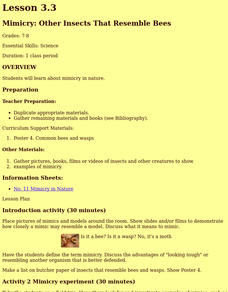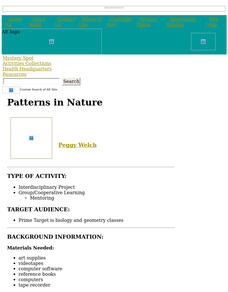American Museum of Natural History
Wonderful World of Wasps
Shockingly, wasps sometimes challenge lions as the king of predators! Learners explore the life of a wasp in an interactive online lesson. They read about the characteristics of wasps and then complete activities to learn about their lives.
Cornell University
Wasps and Ladybugs
Can a good bug ever become a bad bug? An elementary entomology resource explores what to do when too many ladybugs or too many bees are in your home and can become a problem.
Curated OER
Bee and Wasp Identification
Students study the differences between honey bee, bumble bee, paper wasp, and yellow jackets. In this insect classification instructional activity, students study posters of various bees and wasps. Students read the story Holly Honey Bee...
Curated OER
Nasonia Genetics-A Jewel of a Wasp
Students investigate the inheritance pattern of eye color in Nasonia wasps. In this genetics and inheritance lesson plan, students read about the life cycle of Nasonia wasps and hypothesize about the possibilities of eye color inherited...
American Museum of Natural History
You are the Queen
A day in the life of a wasp queen is not as royal as it may sound. Pupils assume the role of the wasp queen to complete an interactive activity that simulates building a colony. They make decisions along the way and note the changes from...
Core Knowledge Foundation
Insects Tell It Again!™ Read-Aloud Anthology
A read-aloud anthology explores the world of bees, wasps, beetles, termites, ants, fireflies, and more. Scholars listen to stories and discuss topics and practice word work. Extension opportunities keep the learning going in and out of...
Curated OER
Bees and Wasps
In this biology worksheet, students look for the details that are common to the insects. Then they label the parts for the two diagrams.
Denver Art Museum
Words-A-Buzz
Here's an art lesson for pre-schoolers which focuses on communicating through words and movement. Learners explore the traditions of the samurai grip enhancers and characteristics of wasps. Photographs, embedded in the plan, of these...
National Endowment for the Humanities
Fly Girls: Women Aviators in World War II
Explore contributions of Women Airforce Service Pilots (WASPs) during World War II with an engaging history lesson. Middle schoolers examine portrayals of women in World War II posters and newsreels, compare and contrast them with...
Curated OER
Chain Reaction
Students read a magazine on chain reaction and complete an included crossword puzzle. They select one interesting fact they learned and share it with the class, playing a game of truths and lie. Next, the students create 3 statements,...
Curated OER
Watch Out for the Wasp!
Students increase their reading fluency through the use of various strategies. After reviewing chunking and rereading, students complete an initial read of a novel text. Working with a partner, they read complete a timed assessment of...
Curated OER
Mimicry: Other Insects That Resemble Bees
Students design a conceptual experiment to test whether mimics actually benefit from the fact they resemble other organisms or objects. They define the term mimicry. They focus on insects that resemble bees and wasps.
Curated OER
Word Search: Insects
In this word search worksheet, students locate fifteen words related to insects. Words include beehive, ant, wasp, spider, and ladybug.
Curated OER
Women Air Force Service Pilots
Tenth graders evaluate the contributions of female services pilots during World War II. They discuss the service of the women as well as the conditions they confronted. Students compare and contrast the treatment of male and female...
Curated OER
Adopt-An-Insect
In this biology worksheet, middle schoolers locate examples of various types of insects listed in the chart and receive a point value for each according to its significance. Then they identify body parts and habitat for each item.
Curated OER
Household Pests
Sixth graders discover the various habitat requirements for assorted household pests from ants to wasps. They conduct various activities including researching the life cycles moths, cockroaches, and mosquitoes
Curated OER
Insect Classification
Students compare and contrast the visible structures of three insects based on photographs. They differentiate characteristics of crane flies, ants, and wasps then create a simple classification system.
Curated OER
Patterns in Nature
Research patterns in nature which illustrate biological and mathematical concepts. Your class will discover and explore aspects of fractals, Fibonaccis numbers, whale and butterfly migration patterns, whale identification, flower...
Curated OER
Darwin’s Bees
What do you call a bee born in May? A maybe! This first instructional activity in a series of four begins with a starter activity to get scholars thinking about the topic. Then a circus, or circuit of seven activities, show Darwin's...
Curated OER
5 Step Food Chain Lesson
Have your class discuss food chains using this resource. Learners watch a presentation on the food chain and how we are dependent on the smallest life forms. They write newspaper articles and create an illustration describing the food...
Prairie View A&M University
Passive Voice
Often deemed the weak voice, the passive voice is often a stylistic choice in many narratives. This presentation, created by Prairie View A&M University, details the pros and cons of using the passive voice.
Curated OER
Fantastic Flower
Here is a clever lesson on pollination of flowers for you. In it, learners study the anatomy of a flower, and play a game in which they simulate the process of pollination. This fine plan brings in elements of art, physical education,...
Curated OER
Rainforest Complexity and Diversity
Second graders investigate the diversity of plants and animals in a rainforest. They watch an online story developed by the Rainforest Alliance, observe and record animals in their local area, explore various websites, and compare and...
Curated OER
Poetry In Song
Investigate poetry and song lyrics with your class. They will identify poetic elements in their favorite modern music. Then they will play their song choice aloud for their classmates.
Other popular searches
- Insects Wasps
- Wasps Nest
- The Wasps
- Insects Wasps
- Sea Wasp
- Paper Wasp
- Life Cycle Wasp
- Bees and Wasps
- Thw Wasps
- Wasp Hives
- Thaw Wasps

























